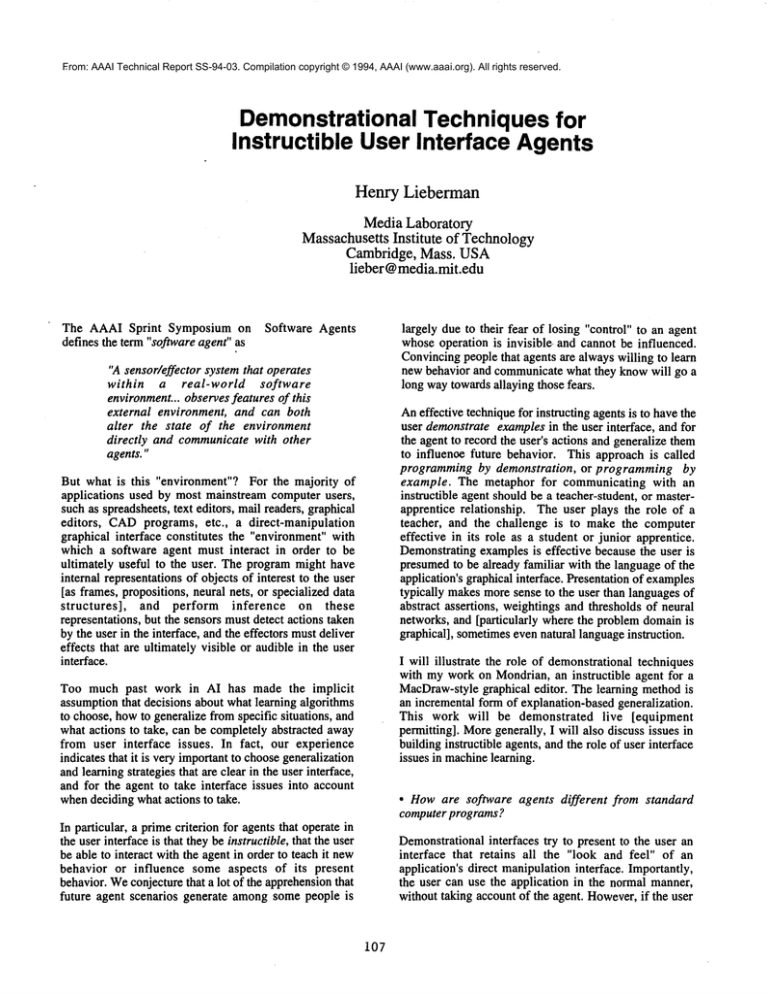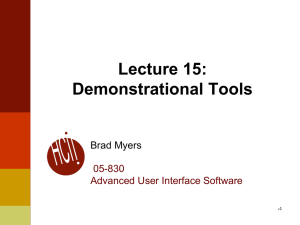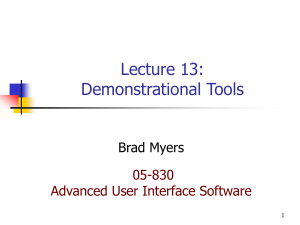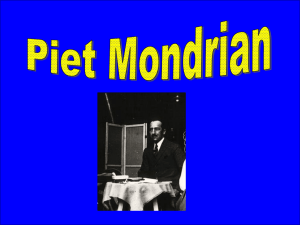
From: AAAI Technical Report SS-94-03. Compilation copyright © 1994, AAAI (www.aaai.org). All rights reserved.
DemonstrationalTechniquesfor
Instructible UserInterface Agents
Henry Lieberman
MediaLaboratory
Massachusetts
Institute of Technology
Cambridge,Mass. USA
lieber @media.mit.edu
The AAAI Sprint Symposium on
defines the term "software agent" as
Software Agents
largely due to their fear of losing "control" to an agent
whose operation is invisible and cannot be influenced.
Convincingpeople that agents are always willing to learn
new behavior and communicatewhat they know will go a
long waytowards allaying those fears.
"A sensor/effector system that operates
within a real-world
software
environment.., observes features of this
external environment, and can both
alter the state of the environment
directly and communicate with other
agents."
Aneffective techniquefor instructing agents is to havethe
user demonstrate examples in the user interface, and for
the agent to record the user’s actions and generalize them
to influenoe future behavior. This approach is called
programming by demonstration, or programming by
example. The metaphor for communicating with an
instructible agent should be a teacher-student, or masterapprentice relationship. The user plays the role of a
teacher, and the challenge is to make the computer
effective in its role as a student or junior apprentice.
Demonstrating examplesis effective because the user is
presumedto be already familiar with the language of the
application’s graphical interface. Presentation of examples
typically makesmore sense to the user than languages of
abstract assertions, weightings and thresholds of neural
networks, and [particularly where the problem domainis
graphical], sometimeseven natural language instruction.
But what is this "environment"? For the majority of
applications used by most mainstream computer users,
such as spreadsheets, text editors, mail readers, graphical
editors, CADprograms, etc., a direct-manipulation
graphical interface constitutes the "environment" with
which a software agent must interact in order to be
ultimately useful to the user. The program might have
internal representations of objects of interest to the user
[as frames, propositions, neural nets, or specialized data
structures],
and perform inference
on these
representations, but the sensors must detect actions taken
by the user in the interface, and the effectors must deliver
effects that are ultimately visible or audible in the user
interface.
I will illustrate the role of demonstrational techniques
with mywork on Mondrian, an instructible agent for a
MacDraw-stylegraphical editor. The learning methodis
an incremental form of explanation-based generalization.
This work will be demonstrated live [equipment
permitting]. Moregenerally, I will also discuss issues in
building instructible agents, and the role of user interface
issues in machinelearning.
Too much past work in AI has made the implicit
assumption that decisions about what learning algorithms
to choose, howto generalize from specific situations, and
what actions to take, can be completely abstracted away
from user interface issues. In fact, our experience
indicates that it is very importantto choosegeneralization
and learning strategies that are clear in the user interface,
and for the agent to take interface issues into account
whendeciding what actions to take.
¯ Howare software agents different
computer programs?
In particular, a prime criterion for agents that operate in
the user interface is that they be instructible, that the user
be able to interact with the agent in order to teach it new
behavior or influence some aspects of its present
behavior. Weconjecture that a lot of the apprehensionthat
future agent scenarios generate amongsome people is
from standard
Demonstrational interfaces try to present to the user an
interface that retains all the "look and feel" of an
application’s direct manipulation interface. Importantly,
the user can use the application in the normal manner,
without taking account of the agent. However,if the user
107
Theillustration showsthe interface to Mondrian,anobject-orientedgraphicaleditor augmented
with
an instructible user interface agentthat learns procedures
fromexamples.
Here,the systemis being
shownhowto disassemble
a circuit board. Theagentrecordsuser actions, andproducesa program
capableof performingan analogous
procedure
on a different circuit board, usingan incrementalform
of explanation-based
generalization.
Thesystemrepresentsoperationswith dominoicons that presentbefore-and-afterpictures of each
command.
Thelower portion of the picture showsa storyboardthatdisplays recordedimagesof the
history of operationsandautomatically-generated
natural languagedescriptionsof eachstep. The
systemalso usesspeechoutputfor feedback,andacceptsspeechinput to advisethe generalization
process.
for similarities and differences betweenstates. Mondrian
adopts the former approach. A variety of machine
learning strategies described in the literature can be
appropriate, but attention needs to be paid to howthe
learning is perceived in the interface. There is a tradeoff
between making the learning algorithm "smarter" and
maintaining its understandability to the user. Mondrian
uses a form of incremental
explanation-based
generalization which notices a set of relations deemed
"significant" in the input, and tracks depedencies of
actions. Voice input is used to disambiguate potentially
ambiguous generalizations.
An architecture
for
introducing domain-dependent generalizations
is
included.
can direct the system to look "over the user’s shoulder"
and learn new behavior from watching examples. In some
agents, the "record" modeis on all the time and the agent
proposes suggestions automatically. There are a few
operations that allow the user to explicitly communicate
with the agent and the agent provides visual feedback
about what it has learned. To the user, the application
operates normally, but the interface can be extended with
new behavior or repeated patterns of behavior can be
automated.
¯ Whatare appropriate software agent architectures?
There is a range of choices that can be made for
architectures for demonstrational agents. One important
choice is whether the agent records and generalizes
actions, or whether it records successive states and looks
108
¯ What are appropriate languages for inter-agent
communication ?
¯ Is explicit representation of capabilities and states of
other agents necessary for the success of software agents?
¯ Whatare appropriate "social laws"for societies of
agents ?
over time; howthe agent can control level of detail in
communication with the user; and how long-term global
changes in behavior can be managed.
Unfortunately, there are not yet any multiple-agent
demonstrational interfaces. I can at most speculate on how
multiple agent societies might be integrated into a
demonstrational
model. However, even the
demonstrational interfaces that exist so far are "multiagent" in the sense that the user acts as an agent as well as
the software. Thus many aspects of inter-agent
communicate are reflected in the user interface. A
language for communicatingbetween two software agents
can then take on someof the characteristics of user-agent
communication. This suggests that inter-agent
communicationshould be done by example as well.
Major support for this work comes from research grants
from Alenia Corp., Apple Computer, ARPA/JNIDSand
the National Science Foundation. The research was also
sponsored in part by grants from Digital EquipmentCorp.,
HP, and NYNEX.
Acknowledgments
References
[Cypher, ed. 93] Cypher, Allen, ed. Watch What I Do:
Programmingby Demonstration, MITPress, 1993.
[Lieberman 92] Lieberman, Henry, Capturing Design
Expertise by Example, in East-West Conference on
Human-Computer
Interaction, St. Petersburg, Russia,
August 1992.
[Lieberman 93a] Lieberman, Henry, Mondrian: A
TeachableGraphical Editor, in [2].
¯ Whatare fundamentallearning problems for software
agents?
Generalizing from user actions is the major problemfor a
demonstrational software agent. What relations are
noticed by the agent? Howdoes a user communicatehis
or her desires to an agent? Howdoes the agent give
feedbackto the user about what it has learned, so that the
user can verify that his or her instructions have been
correctly understood? Howdoes the user make changes
to the behavior of an already existing agent? Howcan the
user learn what existing agents are capable of, or choose
betweenalternative agents?
¯ Howdo the notions of planning and execution in
software domainscomparewith the classical notions?
"Planning" corresponds to what the agent does when it
initially records a demonstrationfrom recording the user’s
actions. The recorded procedure constitutes a plan for
dealing with future examples. "Execution" occurs when
applying this plan to a new example. This amounts to
making an analogy between the example initially
presented and the new example. There exists a need for
"execution monitoring", at least to be able to debug the
executionif the result is not as desired.
¯ What mechanismsare necessary to ensure long-term
agent survival?
Probablythe maincriterion for long-term agent survival is
if the humanuser is happy with howthe agent behaves in
the interface! Somecriteria that will begin to emerge
after agents have had substantial lifetimes are howthe
agent can managelarge sets of examples as they grow
109





